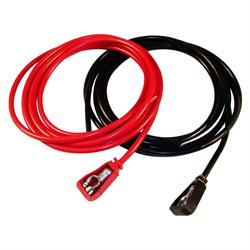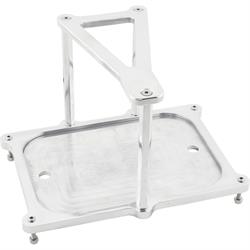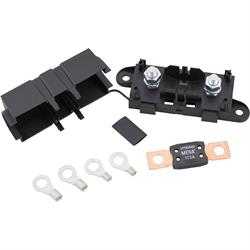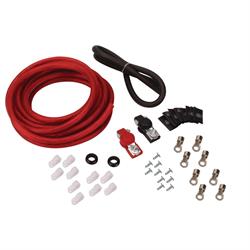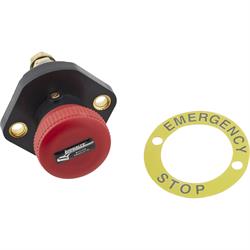Battery Relocation to Trunk or Other Area of Your Vehicle
What is Battery Relocation?
Many people think of battery relocation as moving your vehicle’s battery from the engine compartment to the trunk, and you’d be right. But technically speaking battery relocation can be from any mounting point to another. For example, many classic trucks that use 6-volt charging systems feature frame mounted battery boxes under the cab that do not support larger 12-volt batteries. Owners will sometimes retrofit a 12-volt battery box to the frame or mounting tray under the hood for easier access. Whatever your battery location needs are, there are several things to consider when doing so to not only ensure the battery is safely mounted, but that your charging system wiring is appropriately sized to handle your charging system output.
Battery Relocation Pros and Cons
Moving your battery from the engine compartment to the trunk (or relocating battery to bed of truck, etc.) has many benefits. However, all is not without some concerns. You can review our pros and cons listed below and determine if battery relocation is something you feel you will benefit from in your ride and then read on to learn how to relocate a battery. As always, use best practices for your own safety when handling 12V automotive batteries, including relocating battery to the trunk, jump starting, terminal maintenance, and more.
Battery Relocation Pros
- Cleaner engine compartment
- More room in the engine compartment to mount ignition controls, intercooler tank, etc.
- Better weight balance/distribution, can help with corner weights
- Ability to tuck/hide wiring more easily
- Able to install a much larger battery than what fits in the stock tray under the hood
Battery Relocation Cons
- Often extensive wiring modifications to charging system wiring needed
- Requires venting battery gasses to outside of vehicle in most cases
- Adding weight to trunk of car that may create poor weight balance in some instances
- Most sanctioning bodies require the battery be in a sealed box
- Additional expense of battery tray/box and remote cutoff switch
- Takes up trunk space that may be at a premium in small cars or convertibles
- Possible access issues if trunk key is lost (most cars through the ’70s had no hood lock)
Why Relocate Battery to Trunk?
Installing your battery in the trunk area is the most common spot for several reasons. Primarily is the ability to move weight (often 30 or more pounds) from in front of the front axle line to over or just behind the rear axle line. This is a tremendous help in weight transfer in many racing applications. Additionally, many install their battery in the trunk to clean up the engine bay appearance and/or make room for things like turbo chargers, intercooler water tanks, ignition amplifiers, remote mounted ignition coils, and more.
But why a trunk mounted battery? Why not inside the car on the firewall or possibly where the passenger seat used to reside, etc.? For one, moving the battery from the engine compartment to just inside the firewall area doesn’t transfer enough weight to make the move viable. Secondly, when relocating a battery most rule books require the battery to be out of the passenger compartment all together, making the trunk the most logical (and safest) place to move the battery to. For hatchback vehicles some sanctioning bodies will require a bulkhead to be built or a specific material battery box with venting to outside the body used to protect the driver from the battery in the event of a “bad day” on track. So be sure to consult your rules before moving forward on relocating your battery so you don’t waste time or money, or worst of all, not pass tech!
Briefly, when relocating battery to the trunk it is usually to achieve better weight distribution/transfer and for safety. Two particularly important things when it comes to racing, no matter if it is drag racing, autocross/road racing, circle track, or open road rally competition. Moving the battery to the rear of the car accomplishes both needs by moving the weight to a more effective location and placing the battery in an enclosed area away from the driver.
How To Relocate Battery to Trunk?
The relocation process can be broken down into just a few basic steps to follow:
- Remove existing battery, battery tray/hold down, and battery cables
- Find suitable location to mount battery in trunk/rear of vehicle
- Fabricate/buy mounting solution to secure battery in new location
- Choose proper battery cable wire size and route cable from battery to starter
- Choose proper charging cable wire size and route from starter to alternator
- Ground battery negative terminal to clean ground source in trunk/rear of vehicle
Every trunk mounted battery installation is different, so we’re just discussing general wiring steps here found in the typical battery relocation kit. You will have to determine if you wish to route your battery cable inside or outside your car, types of battery terminals to use, and how to pass the cable through the body when needed. You can simply drill a hole and use a grommet, or you can add bulkhead connectors to connect your battery cable through firewall or other sheetmetal panel.
The same goes for your power feed junction under the hood. You can use the battery stud on the starter, or you can run a properly sized wire from the starter to a small power distribution stud where you can then run power to your fuse box and other electrical devices.
You can run your alternator charge wire to the power distribution stud shown above or directly to the starter stud. A 6-gauge wire will usually suffice unless you are running a big alternator. Be sure to use an inline fuse to protect the charging system circuit as well. Some people prefer to use a Ford-style starter solenoid mounted near the trunk mounted battery so that the large red cable to the starter is only hot when the starter is cranking. This does require an additional fuse protected wire to be run to the front of the car to power the fuse box and other items, but some feel this is much safer than the large red cable, which cannot be fuse protected. See our car battery wiring diagram below to get you started.
Trunk Mounted Battery Wiring Diagram
We have also provided a larger version of the battery relocation diagram for your viewing needs that can be printed out and used as a template for your project.
Lastly, if desired, or required for your racing sanctioning body, install and wire in a battery cutoff switch. Some will require a rotary switch, others will require a push/pull switch, so double check your rule book once again. The same goes for where to mount the cutoff switch. Always check with your sanctioning body or local race track before mounting and wiring your cutoff switch. Often you will find that some want the switch at the rear of the car, while others will want them within the driver’s reach or at the base of the windshield on the roll bar down tube for a corner worker to access easily if the driver is not able to. When in doubt, the rule book takes precedence.
One additional note on battery cutoff switches. Most sanctioning bodies require the positive cable to be interrupted when the switch is tripped. This can create a dangerous voltage spike if the alternator is not interrupted at the same time. This can damage sensitive EFI electronics. In these cases, we recommend a four-pole disconnect switch, which has a separate circuit for your alternator. And while automotive batteries are generally safe to handle due to their low voltage, you do need to be careful about electrical shorts, battery venting, and of course leakage if the case is damaged. So, while a cutoff switch may be mandatory, in the event of a wreck on track be aware that the battery case may have been compromised or a direct short to the battery terminals from sheetmetal can still occur.
What Gauge Wire for Battery Relocation?
Does battery cable size matter? It most certainly does! Even when the battery relocation is to the engine compartment with shorter cable runs, quality fine stranded wire of the proper size will provide the best voltage and amperage with minimal “drop” to the output. Moving the battery to the rear can amplify these issues if proper cable sizing isn’t used. So, what gauge are battery cables? Standard battery cables used by OEMs for batteries mounted in the engine compartment are typically 4-gauge or sometimes will be 2-gauge in heavy duty applications.
What size wire for battery cable sizing will be dependent upon the amp load and the length of the cable when putting your battery in the trunk. Generally speaking, you can usually use 2-gauge cable if the distance isn’t too far, but for longer runs you’re going to be looking at a minimum of 1-gauge wire and most likely 0-gauge (1/0). See the wire ampacity chart below to determine wire gauge size versus distance.
Battery Cable and Alternator Charge Wire Amperage Capacity by Size and Wire Length
We have also provided a larger wire amperage capacity chart for your viewing needs
Always use automotive grade wire with proper insulation that is chemical and fuel resistant. If you stick with the SAE J-1127 battery cable specification when searching for your battery cable needs, you know you’ll have the proper cable to get the job done. We know a lot of people use “welding cable” for battery relocation due to their finer copper wire strands and more flexible insulation, but there are some great battery cable types that use fine strand copper and flexible insulation as well.
Battery Relocation Ground Wire Considerations
Where does the battery ground wire go when placing the battery in the trunk? There are two schools of thought when it comes to where to ground negative battery cable when relocating battery to the trunk area. One method is to simply clean and prepare a solid metal ground location near the relocated battery and run a short ground cable to this location (with the same size wire as your positive lead that runs to the front of the car). Often a rear frame rail or major metal structure at the rear of the car will suffice. The second option is to run the ground cable along with the positive cable to the front of the car and ground it at the original location, whatever that may be (frame rail, engine block, firewall, etc.).
Whatever option you decide, having your engine grounded to the unibody/frame is critical, so use ground straps between body and frame and engine and frame. When it comes to how to ground a car battery we also highly encourage through bolting of any ground, be it up front or in the trunk, versus using a tapping screw or even a threaded insert in the frame. Clean to bare metal, use a through bolt with appropriately sized washers and a lock nut of some sort to prevent the ground cable from loosening.
Thoughts On Race Car Battery Wiring
When it comes to racing, every ounce of a race car’s weight is given consideration. Not only overall weight, but where that weight is placed within the chassis (relative to rule book limitations of course). Many race cars use compact and lightweight lithium racing batteries that often save over 50 percent of the weight of a traditional lead acid wet battery or AGM style battery. So, it makes sense that using the smallest/lightest battery wiring possible will help when it comes to keeping a race car’s weight in check. There are racing specific battery cables available that use lighter copper clad aluminum (CCA) wire and thinner insulation. This doesn’t sound like much, but over the run of 15 or so feet it does add up. Obviously, placing the battery closer to the starter will shorten your wire length needs (less weight) but may not place your battery in an optimum location for weight transfer. This is also why many racers use ultra small lithium batteries where the weight is of much less concern and can be mounted closer to the starter.
Can a Car Battery Get Wet?
Many people ask what happens if a car battery gets wet? Getting a battery wet used to be an issue with vented batteries or batteries that had removable caps to service the battery’s water level. However, today’s sealed high performance batteries require no servicing and have no removable caps. As such, using them for under chassis mounting in pickups or other applications is of no risk to the battery relocation. Generally, the biggest issue with under car mounting is lack of maintenance due to the “out of sight, out of mind” mentality. Sealed batteries can still create corrosion at the battery terminals and require periodic inspection and maintenance.
Remember that when considering mounting a battery under a pickup bed or down on the frame where it requires under car access. And if you do mount your battery in a hard to access location, we highly recommend remote battery terminals be installed to allow maintenance charging, the ability to connect jumper cables, or a lithium jumper pack if you find yourself with a dead battery.
What Do I Need for Battery Relocation?
While Speedway Motors offers several battery relocation kits that handle the battery mounting and main battery cabling needs, we’ve put together some additional product lists based upon popular applications, such as street use, drag racing, and the ever popular classic pickup truck, to enable you to ensure your battery relocation goes smoothly.
Street Battery Relocation Parts List
Street Battery Relocation Parts List (view price and availability)
Drag Race Battery Relocation (No Alternator) Parts List
Drag Race Battery Relocation Parts List (view price and availability)
Classic Truck Battery Relocation Parts List
Pickup Battery Relocation Parts List (view price and availability)








